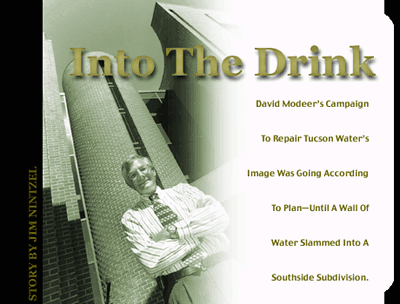
Can David Modeer Fix The Stinking Mess That Is Tucson Water?
By Jim Nintzel
DAVID MODEER KNEW he was stepping into mud when he signed
on as director of Tucson Water. Ever since the disastrous delivery
of CAP water in the early 1990s, the city-owned utility has been
caught in a political whirlpool that has already pulled down two
men from the top.
 After five years on the job, Michael Tubbs quit in 1993, one
day after the City Council voted to shut down direct delivery
of CAP water in response to thousands of complaints about brown,
smelly water and broken pipes.
After five years on the job, Michael Tubbs quit in 1993, one
day after the City Council voted to shut down direct delivery
of CAP water in response to thousands of complaints about brown,
smelly water and broken pipes.
His successor, Kent McClain, was relieved of his responsibility
after two years on the job. According to his own sworn testimony
in 1997, McClain, who earned close to $95,000 annually, spent
most of his last year at Tucson Water watching television in his
office.
So why did Modeer leave a high-level job with the largest water
utility conglomerate in the nation for tumultuous Tucson?
"I looked at it as a challenge," says the 52-year-old
Modeer, who, since his arrival last August, has already become
a familiar face, starring in a series of full-page ads in the
daily papers and frequent friendly spots on television and radio.
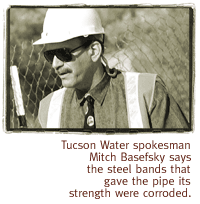 Modeer, who is paid $115,000 a year, has also been trying to
find a way to use CAP water while ostensibly staying within the
bounds of the Water Consumer Protection Act, the voter-passed
law that has banned direct delivery of CAP water since 1995. He
and his staff have been putting the final touches on the utility's
million-dollar-plus demonstration project to deliver a blend of
CAP and groundwater to about 100 volunteer households. Modeer
has a March date in front of the City Council to give an update
on the project.
Modeer, who is paid $115,000 a year, has also been trying to
find a way to use CAP water while ostensibly staying within the
bounds of the Water Consumer Protection Act, the voter-passed
law that has banned direct delivery of CAP water since 1995. He
and his staff have been putting the final touches on the utility's
million-dollar-plus demonstration project to deliver a blend of
CAP and groundwater to about 100 volunteer households. Modeer
has a March date in front of the City Council to give an update
on the project.
His honeymoon came to an abrupt end last month, when one of the
utility's largest water mains burst in a southwest Tucson neighborhood.
In less than an hour, 38 million gallons of water erupted from
the hole, sending a raging flood directly into the subdivision
downhill at the corner of Starr Pass Boulevard and Greasewood
Road. The torrent swept through roughly two dozen homes, leaving
four so badly damaged the city will now buy and demolish them--to
develop better flood protection.
But the damage from the burst pipeline--sure to top a million
dollars by the time the investigation is complete--is tiny, compared
to the damage it might have done to Tucson Water's recently launched
campaign to cleanse its image.
THE BURST MAIN runs from the city's Clearwell Reservoir
across Tucson, feeding a network of subsidiary pipes. Installed
in the late 1980s, it was designed to be the sole pipeline to
carry CAP water, following its chemical bath at the troubled $80-million-plus
Hayden-Udall Treatment Plant, from Clearwell into the city's system.
Critics of Tucson Water have suggested that had the pipeline
failed under Tucson Water's original delivery plans, nearly the
entire city would have gone dry until groundwater wells could
be reactivated.
Modeer insists that would have never happened. "It would
have been a more difficult response situation, but we wouldn't
have been out of water," Modeer says. "In the case of
an emergency like this, we would have...anywhere to one-and-three-quarters
to two-days' storage. We could get all our wells back on in eight
hours. They're not going to be retired. The original plan was
to take them off line but to continue to keep these wells in a
situation where they could be activated again. There may have
been a few of them that, because of the condition of the water
in them, would be taken off service because we would have felt
they were not needed any more, but the majority of the wells would
have been maintained, knowing that there would be times when the
CAP canal might be down for maintenance or any other circumstance
you might need these wells. In my discussions with the people
in operations, there was never the intent to totally retire these
wells."
Modeer's assertion seems to be contradicted in a U.S. Bureau
of Reclamation Environmental Impact Statement completed less than
a year ago, in April 1998, regarding a proposed CAP storage reservoir
and recreational lake. (The reservoir project is currently in
limbo, while the city develops a plan to use CAP water.) To justify
asking the federal government to spend $50 million to $60 million
constructing the 15,000-acre-foot terminal-storage facility covering
200-plus acres southwest of the city, Tucson Water told the federal
government it planned to shut down its wells.
"The city of Tucson had planned to reduce both the number
of groundwater wells it operates and the amount of groundwater
pumped, while increasing direct use of CAP," the report says.
"This plan would entail shutting down the majority of the
groundwater system. The cost of maintaining a fully redundant
groundwater system, while continuing to purchase and treat CAP
water to meet all demands, was deemed cost-prohibitive by Tucson
Water. Tucson Water believes there would be sufficient advance
warning of any long-term storage or outage that would allow time
to bring the groundwater system back on line. Tucson Water has
indicated that operational impacts, water-quality changes and
aesthetic problems associated with switching between CAP water
and groundwater as the base supply would be acceptable only if
switching occurs on an infrequent basis, in which operation of
the groundwater system would be required over an extended period
of time."
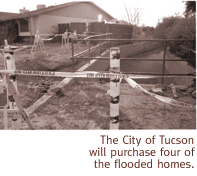 Tucson Water spokesman Mitch Basefsky says "there really
is no discrepancy. A shutdown of the wells doesn't mean you take
them out of service completely. All it means is you don't have
to run them. You just maintain them in a back-up mode."
Tucson Water spokesman Mitch Basefsky says "there really
is no discrepancy. A shutdown of the wells doesn't mean you take
them out of service completely. All it means is you don't have
to run them. You just maintain them in a back-up mode."
But if the wells can be reactivated in a matter of hours, why
should the federal government spend at least $50 million dollars
on a storage reservoir--especially given the amount of water that
would be lost to evaporation?
THE SHATTERED MAIN has a concrete interior wrapped in steel
cables, which give the pipe most of its strength. A layer of mortar
covers the bands to protect them from corrosion. Until recently,
Modeer says, the design was considered virtually indestructible.
But in the last decade, pipes like these have failed more than
150 times, particularly in the western United States. Often, the
break is caused by corrosion weakening the steel cables.
Although Modeer estimates the investigation into the pipeline
break will take another two months, Tucson's broken pipe was certainly
the result of corrosion.
An underground flow of water has emerged as one likely culprit.
In the late '80s, construction crews digging a trench for the
pipeline along Starr Pass Boulevard blasted through a bed of rock.
Before long, workers discovered water was rising into their ditch
and running downhill. They'd accidentally disturbed the natural
underground flow of water from the Tucson Mountains to the valley's
basin. The water, which rose and fell in relation to rainfall,
began running through the trench and collecting beneath the Greasewood/Starr
Pass intersection, which sank four times before Tucson Water engineers
were able to install a system of drains to alleviate that problem.
But the stream still ran beneath the pipeline, which may have
triggered a chemical reaction that destroyed the mortar's ability
to protect the steel bands against corrosion. "If there is
a wetting-and-drying cycle, that could cause problems with the
concrete," says Modeer.
The pipeline's troubled history came up during a 1996 deposition
in Tidwell V. City of Tucson, a lawsuit facing the city
over the damage to homes and businesses caused by the direct delivery
of CAP water. (The lawsuit--and its subsequent million-dollar-plus
bill for Tucson Water customers--has yet to be settled.) When
attorneys for the plaintiffs asked Tucson Water employee Jim Patterson
about the pipeline, he told them he complained to his supervisors
about numerous problems he discovered when he inspected the main
in the winter of '89-'90, before Tucson Water began delivering
CAP water. Among his complaints, he said Tucson Water officials
didn't take proper precautions to deal with the groundwater when
they installed the pipe.
"They chose to use dirt as a fill rather than gravel, just
dirt, and if the water runs constantly under there through this
dirt, it does what is called 'washes the fines out,' " testified
Patterson, who has declined all interviews with the media since
the disaster. "It actually washes the dirt out from under
the pipe and eventually some day the pipe just settles and breaks,
it can't be fixed."
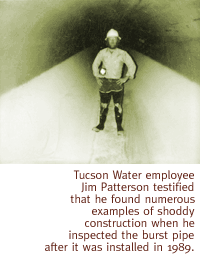 Tucson Water spokesman Basefsky insists the section of pipe that
broke did have a gravel base. "We know it did," he says.
"We're getting the records of what was actually used. We
have people's recollections, and people's recollections don't
match Jim Patterson's recollections."
Tucson Water spokesman Basefsky insists the section of pipe that
broke did have a gravel base. "We know it did," he says.
"We're getting the records of what was actually used. We
have people's recollections, and people's recollections don't
match Jim Patterson's recollections."
But the pipeline controversy didn't end there, according to Patterson,
who catalogued a number of substandard construction problems in
his 1996 deposition. "The first day I went to the main I
didn't like what I saw," Patterson told attorneys.
To begin with, the pipe was lined with damaged valves, which
adjust pressure in the pipeline. "They didn't meet the specs,"
Patterson says in his deposition. "They installed the wrong
units, backwards, corroded, not laid out properly, just various--let
me put it this way: I think I found one that was right."
Patterson was more descriptive in a 1993 interview with city
auditors. "The plans sucked," he told them. "But
they didn't--then the contractor didn't even do the...plans. Nothing
from...engineering to insulation. It's a wonder.... They had underground
water that started running underneath the main...There's things
you can do, but they did nothing.... They don't know what to do
about it and it's going to break the main, I'll guarantee you,
and then they'll end up--eventually, it's going to break, and
when it breaks it--we're talking to people up at the factory that
makes the pipe, it's going to take up to three weeks to get a
replacement piece here."
Basefsky says Tucson Water spent a half-million dollars repairing
the pipeline, but the utility is still assembling records that
would reveal the extent of the repairs, because many of the documents
are now in the hands of the utility's attorneys, who are fighting
battles related to the Tidwell suit.
Modeer says he doesn't believe any of Patterson's concerns could
have led to the pipe break. Even so, the record shows that Tucson
Water passed the costs of addressing those concerns on to ratepayers
rather than pursuing the contractor, who refused to make repairs.
Patterson testified in 1996 that when he suggested the repairs
should be the responsibility of the contractor, he was told three
different stories by his supervisors. First, he was told the line
was "out of warranty."
"I dug around and found that it wasn't," he said. "Then
I was told the contractor declared bankruptcy. So I dug around
a little more, got a copy of the original contract and started
asking about bonding companies. Then I was told we just needed
to hurry and get it on line."
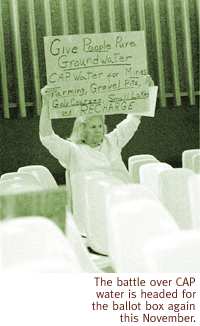 Patterson complained to city staff, members of the City Council
and even the state Attorney General's Office about the costly
repairs. Eventually, a 1993 city audit backed up Patterson's allegations.
"Based on our review, we noted Tucson Water engineers were
aware of some amount of defective workmanship prior to the end
of the contract warranty period," the report states. "Furthermore,
we understand that termination of the warranty period is not a
defense against poor workmanship or defective materials. Thus,
it is not clear why Tucson Water did not aggressively pursue remedy
through the bonding company, since the contractor would not perform
the necessary repairs.
Patterson complained to city staff, members of the City Council
and even the state Attorney General's Office about the costly
repairs. Eventually, a 1993 city audit backed up Patterson's allegations.
"Based on our review, we noted Tucson Water engineers were
aware of some amount of defective workmanship prior to the end
of the contract warranty period," the report states. "Furthermore,
we understand that termination of the warranty period is not a
defense against poor workmanship or defective materials. Thus,
it is not clear why Tucson Water did not aggressively pursue remedy
through the bonding company, since the contractor would not perform
the necessary repairs.
"In our opinion, Tucson Water officials did not aggressively
pursue whether the contractor's bonding company would provide
for satisfactory repairs of the east main based on identified
faulty construction," the report concludes. "Although
the contractor and the Procurement Department were contacted regarding
this issue, further action was not initiated with the bonding
company to secure the repairs or reimburse the city for contracted
repairs."
HAVING THESE KINDS of documents leaking from City Hall
isn't making it any easier to rehabilitate Tucson Water's tarnished
image--a job Modeer tackled aggressively almost as soon as he
arrived on the job last August.
Modeer had spent the last seven years in Pennsylvania working
as a vice-president of Pennsylvania American Water, a subsidiary
of American Water Works, the largest private water company conglomerate
in the nation. He says the Tucson Water job "met what I kind
of wanted to finish up my career in the water utility business
doing. The past 15 years I've been at a policy-setting level and
not involved in day-to-day operations in a community. I knew a
little bit about the problems Tucson had--certainly not in great
detail--and there was a structure of a challenge to get the community
back to where it should be in terms of operating the utility in
the best interests of the customers and work with Mayor and Council
and all the other groups in the community to see if we can't find
a consensus in solving the water supply issue."
It's an issue that has been stalled since 1995, when 57 percent
of Tucson voters, reacting to the CAP delivery disaster, passed
the Water Consumer Protection Act. The law, put on the ballot
by a handful of water activists funded primarily by local car
dealer Bob Beaudry, banned direct delivery of CAP water. The Growth
Lobby spent about $200,000 supporting an initiative to repeal
the law in 1997, only to see a wider margin--61 percent of the
voters--support retaining it.
"Proposition 200 limits us on how you can use Colorado River
water," Modeer says. "You can't simply use conventional
treatment and delivery like you did in '93 and '94. We can't do
that, because it doesn't meet those strict requirements. We blew
it back then--if we'd done things right, we'd still be using it
today. But unfortunately we didn't, and Prop 200 passed, and
we have to work within those restrictions."
In the last six months, Modeer has invested considerable energy--and
ratepayer dollars--in an advertising campaign. Some of the campaign
was in place before his arrival, but he says he added touches
of his own.
"I would call it public education, not public relations,"
Modeer says of the campaign. "I don't think we need to build
a relationship, other than to the extent that we need to build
a relationship where people can come and get information from
us."
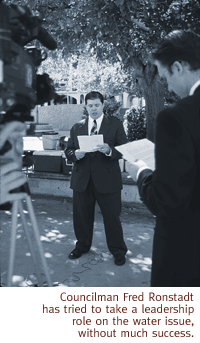 Call it what you will, but know that it's costing a lot of money.
The campaign has been designed by politically connected Kaneen
Advertising, which is paid $100,000 annually to manage Tucson
Water's public relations.
Call it what you will, but know that it's costing a lot of money.
The campaign has been designed by politically connected Kaneen
Advertising, which is paid $100,000 annually to manage Tucson
Water's public relations.
This year, in addition to the $100,000 spent on Kaneen, Tucson
Water is spending $175,000 to buy newspaper and television advertising,
all portraying the utility as a trustworthy friend of the community.
The utility reinforces that image with glossy sheets sent to every
customer each month in water bills. And Tucson Water's propaganda
announcements regularly air on Channel 12, the city's cable television
outlet.
In addition, there's the utility's $650,000 At The Tap program.
Although some of that money is being spent on treatment and corrosion
studies, other dollars are being spent on focus groups and customer
workshops. One recent project was an $80,000 taste-test conducted
by the Massachusetts-based Arthur D. Little firm, which served
various blends of water to volunteers in a survey. The survey
claimed to show a blend of CAP water and groundwater was one of
the top options selected by the group, scoring higher than Tucson's
groundwater.
Besides rebuilding trust in the utility, the campaign seems aimed
at persuading Tucson Water customers to accept CAP water in some
form. Prime example: Tucson Water is gearing up a demonstration
project aimed at delivering a mix of CAP and groundwater to volunteer
neighborhoods that will cost more than $1.4 million. (See "Pricey
Pilot," page 6).
Add it all up, and ratepayers are shelling out a couple million
dollars to improve the badly damaged reputation of the utility
and CAP water.
Some members of the City Council are getting into the act, too.
Earlier this year, pro-growth Tucson Mayor George Miller called
the requirements of the Water Consumer Protection Act "insane"
in his State of the City speech, calling on the community to accept
direct delivery of CAP water or risk economic and environmental
ruin.
Fred Ronstadt, the Council's lone Republican, agrees. "Water
doesn't respond to initiatives put on the table by Bob Beaudry,"
Ronstadt says. "It responds to the law of physics."
Ronstadt has tried to take a leadership role on the water issue,
without much success. Late last year, he changed his mind on a
campaign promise to keep Tucson Water under the control of the
City Council and proposed spinning control of the utility to a
separate Water Board, elected by Tucson Water customers. Candidates
for the water board would have to hold degrees in science or water
law.
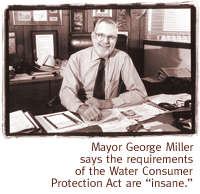 "The idea of having an independent board made up of scientists
rather than politicians I thought made sense. You leave it to
the area of expertise to determine what policy should be and take
that away from the emotional and political realm, but that didn't
go anywhere," Ronstadt says with a self-deprecating laugh.
"The idea of having an independent board made up of scientists
rather than politicians I thought made sense. You leave it to
the area of expertise to determine what policy should be and take
that away from the emotional and political realm, but that didn't
go anywhere," Ronstadt says with a self-deprecating laugh.
A few months later, he jumped to the opposite end of the spectrum,
proposing voters be given the chance to choose a CAP water treatment
process from three options on the November ballot--another plan
that failed to find support among his fellow Council members.
Ronstadt supports Tucson Water's campaign to improve its image.
"They've made strides," he says. "This water main
break was a setback for them, but with David at the helm, they've
made a concerted effort to bring the credibility of the department
back on line."
City Councilman Steve Leal is more skeptical. "On the one
hand the water department needs to improve its image, but it also
needs to improve its substance," says Leal, who, along with
councilmen Jerry Anderson and José Ibarra, opposed the
upcoming demonstration project. Leal is concerned the utility's
advertising campaign may be "spinning the image of the water
Tucson Water wants to sell."
Politically, the proponents of direct delivery don't need to
change the mind of everyone who supported the Water Consumer Protection
Act. They only need to reverse the position of about 15,000 voters
to swing the tide in favor of direct delivery.
Modeer says his media blitz is meant to drive the message that
Tucson Water has changed from the early '90s, when a $268,000
independent audit of the utility blasted its management and service
to customers.
"We started refocusing from more or less an internal technical
group to a customer-oriented organization," Modeer says.
"The attitude in the organization is changing to that. We
need to focus our attention on meeting the needs of the customer.
Not that, 'We know what's best for you, and here's what it's going
to be,' but, 'What do you think is best for you?' and see if we
can design our process and our activities to meet those expectations
of the customer."
But if that expectation includes recharging CAP water in the
central well field, or trading CAP water with mines, farms and
other industrial users, the customers are out of luck. Modeer,
who has the backing of a narrow majority of the City Council,
doesn't believe those are currently viable options.
AT THIS POINT, it's impossible to gauge how much damage
the break has done to Tucson Water's campaign to regain the community's
trust, but a major test will come this November. The Citizens
Alliance for Water Safety, the latest incarnation of the group
that promoted the Water Consumer Protection Act, is gathering
the roughly 10,600 signatures required by July for another vote
on the law--this time, to strengthen it, says Terry Pollock. Pollock,
the local adman who has run campaigns supporting the law, reports
the group already has more than 10,000 signatures and expects
to turn in at least twice that.
According to Pollock, the new law would require the city to begin
recharge efforts in the central well field; extend the life of
the Water Consumer Protection Act; require a supermajority, or
five out of seven votes on the City Council, to raise water rates;
and withhold the pay of City Council members until they are deemed
in compliance with the law.
Modeer optimistically hopes last month's disaster--and the subsequent
negative publicity--hasn't set back the PR campaign. "I don't
think so," says Modeer. "I say that only to the extent
that I think that it's an opportunity to show how we're behaving
from this day forward. I think that our response to the break
was outstanding, along with all the departments in the city who
participated in that."
As the investigation into the disaster continues, Tucson Water
continues to pump groundwater from the central well field while
it tailors its demonstration project in the hope that people will
come to embrace CAP water. But that can't continue much longer--just
about everyone agrees that subsidence is a serious threat. As
water is drawn from the aquifer, the earth settles, damaging the
foundations of homes and businesses. And, as the layers of earth
collapse underground, the aquifer loses its ability to store water.
"There's some recovery after subsidence, but the longer
it goes on the less chance you have," says Modeer. "Once
you get the water out of the lowest level, it's lost forever.
We have to stop doing what we're doing."

|





